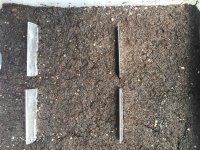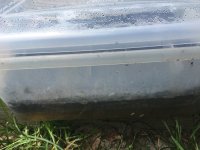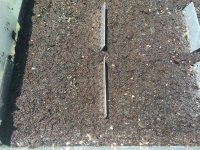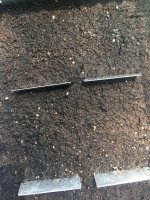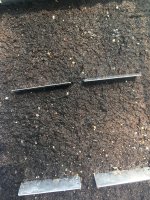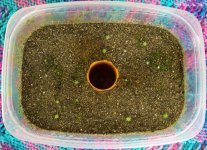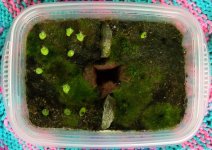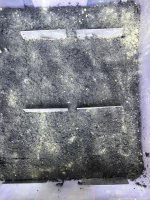-
Members of the previous forum can retrieve their temporary password here, (login and check your PM).
You are using an out of date browser. It may not display this or other websites correctly.
You should upgrade or use an alternative browser.
You should upgrade or use an alternative browser.
Germinating cacti seeds in 3% Hydrogen Peroxide
- Thread starter Wakinyan
- Start date
Migrated topic.
Mitakuye Oyasin
Established member
Interesting. Is there any reason for this over just water?
Auxin
Rising Star
Its been found to help break dormancy in dormant cactus seed half as well as the somewhat extreme sulfuric acid soaking.
'Stimulation and promotion of germination in Opuntia ficus-indica seeds'
Beyond that, provided that non-dormant seeds dont mind hydrogen peroxide (an open question) it would kill pathogens, pests, that slime that can grow on soil when sprouting seeds.
Hydrogen peroxide spray has long been used to kill mold growing in with cactus seedlings, so it wont hurt seedlings.
'Stimulation and promotion of germination in Opuntia ficus-indica seeds'
Beyond that, provided that non-dormant seeds dont mind hydrogen peroxide (an open question) it would kill pathogens, pests, that slime that can grow on soil when sprouting seeds.
Hydrogen peroxide spray has long been used to kill mold growing in with cactus seedlings, so it wont hurt seedlings.
Wakinyan
Rising Star
pete666 said:Is it just a trial or regular technique Wakinyan?
Small trial Pete666
Wakinyan
Rising Star
pete666 said:Is it just a trial or regular technique Wakinyan?
Small trial Pete666
Attachments
Spiralout
Rising Star
I might try this with a few seeds...
I haven't had a great germination rate so far this summer... not sure the exact reason why... My gut is telling me that it's the extreme heat in the greenhouse but I'm not sure how that could have a negative effect...
I'm trying new seeds in round of about 10-15 seeds tops... 24 hours ga3 solution soak, plain water soak etc..
I haven't had a great germination rate so far this summer... not sure the exact reason why... My gut is telling me that it's the extreme heat in the greenhouse but I'm not sure how that could have a negative effect...
I'm trying new seeds in round of about 10-15 seeds tops... 24 hours ga3 solution soak, plain water soak etc..
Wakinyan
Rising Star
pete666 said:Are you spraying it by peroxide everyday?
In the first post you can see that I have the seedlings sitting in a bath of hydrogen peroxide. The bath has never been removed from my seedlings.
Wakinyan
Rising Star
pete666 said:I remember that when I was using peroxide for various applications, I had to refresh new one every two or three days, as it is decomposing and changing just to water and O2 which escapes. Isn't here the same case?
Are you trying to imply that the rules of chemistry do not change simply because the geographic location changes? :shock:
Auxin
Rising Star
With something as complex as soil mix I'll bet the peroxide was fully gone within 24 hours. It reacts with anything it can.
It'll last longer in a petri dish and I've had a 15 year old bottle still be good, but in soil it'll be like a mouse fart in the wind.
If the soil werent saturated I'd say spray with peroxide.
It may be overkill (and too late for your current trial) but when using containers with no drain holes I like to provide a way to add or remove water without disturbing the soil.
I've used little pots, PVC connectors I found, medicine bottles with holes drilled around the bottom, and rocks arranged to make 'canyons'. This way a baster can suck out excess water and a beaker can add water without disturbing the seeds.
It'll last longer in a petri dish and I've had a 15 year old bottle still be good, but in soil it'll be like a mouse fart in the wind.
If the soil werent saturated I'd say spray with peroxide.
It may be overkill (and too late for your current trial) but when using containers with no drain holes I like to provide a way to add or remove water without disturbing the soil.
I've used little pots, PVC connectors I found, medicine bottles with holes drilled around the bottom, and rocks arranged to make 'canyons'. This way a baster can suck out excess water and a beaker can add water without disturbing the seeds.
Attachments
Wakinyan
Rising Star
Auxin said:With something as complex as soil mix I'll bet the peroxide was fully gone within 24 hours. It reacts with anything it can.
It'll last longer in a petri dish and I've had a 15 year old bottle still be good, but in soil it'll be like a mouse fart in the wind.
If the soil werent saturated I'd say spray with peroxide.
It may be overkill (and too late for your current trial) but when using containers with no drain holes I like to provide a way to add or remove water without disturbing the soil.
I've used little pots, PVC connectors I found, medicine bottles with holes drilled around the bottom, and rocks arranged to make 'canyons'. This way a baster can suck out excess water and a beaker can add water without disturbing the seeds.
Your soil mix looks spot on my friend.
Per your suggestion Auxin, I have drained my soil and will continue draining it overnight. I have also dusted lightly with sulfur. In the morning, my plan is to sit my seeds back in a bath of 2 Liters of H202.
Perhaps 2 Liters of H202 added to the soil in the morning will be like a bull moose fart in the wind once it is added to the soil. Those mouse farts... aren't hitting on much.
Keep your fingers crossed for me as I'm almost ready to apply harsher methods of control.
Attachments
Spiralout
Rising Star
Very interesting looking structure design you have setup there auxin..
This is a total noobie question but here we go...
Are there any particular variables that are likely to prevent germination or kill seedlings early on?
Could fungi , unseen by the naked eye, do this?
The reason I ask is... Back a few years ago when I would germinate trichocereus I would have very fast germination and very good germination rates (75-90%) ... I would normally just sow the seeds on top of plain sain in open air and mist them regularly keeping them indoors on the windowsill...
I've been germinating seeds now, after a few years hiatus, and don't seem to be having anywhere near as much success as days gone by.. I've tried a few other methods, such as using various combinations of soil and sand, and have been germinating them in a greenhouse... I'm thinking that maybe the extreme heat (compared to indoors on my windowsill) of the greenhouse may be the culprit.. But that doesn't seem to make sense as I was under the impression that heat is normally a catalyst for germination..
Anyways... I have been starting new seeds over the past few days and am being very conservative about it and using small amounts of seeds to try to dial in the best method to get them going...
One specific question... I know that soaking seeds first helps with germination... But is it ok for them to be saturated with water after the seed shell cracks? I know that having them dry up entirely for too long is not good...
Ok, sorry for the long winded reply and for somewhat derailing the subject... hope you're all doing good.
This is a total noobie question but here we go...
Are there any particular variables that are likely to prevent germination or kill seedlings early on?
Could fungi , unseen by the naked eye, do this?
The reason I ask is... Back a few years ago when I would germinate trichocereus I would have very fast germination and very good germination rates (75-90%) ... I would normally just sow the seeds on top of plain sain in open air and mist them regularly keeping them indoors on the windowsill...
I've been germinating seeds now, after a few years hiatus, and don't seem to be having anywhere near as much success as days gone by.. I've tried a few other methods, such as using various combinations of soil and sand, and have been germinating them in a greenhouse... I'm thinking that maybe the extreme heat (compared to indoors on my windowsill) of the greenhouse may be the culprit.. But that doesn't seem to make sense as I was under the impression that heat is normally a catalyst for germination..
Anyways... I have been starting new seeds over the past few days and am being very conservative about it and using small amounts of seeds to try to dial in the best method to get them going...
One specific question... I know that soaking seeds first helps with germination... But is it ok for them to be saturated with water after the seed shell cracks? I know that having them dry up entirely for too long is not good...
Ok, sorry for the long winded reply and for somewhat derailing the subject... hope you're all doing good.
Auxin
Rising Star
Most cacti can tolerate very moist conditions for the first months, or even first year. Only a relative few need to be transferred to dryish or limestone rich conditions. I've seen popular globulars as well as columnars grown in rainforest conditions for their first 12 months.
Have you considered water hardness as the variable that changed your success rate?
In nature cacti seeds and seedlings get mildly acid rainwater, often while sitting in decomposing acidic fruit. Many of us have pretty hard and alkaline tap water that we feed our plants, this is by design since tap water made basic with things like calcium bicarbonate doesnt corrode pipes.
You could try growing seedlings with rainwater, distilled water, or water freshly acidified to pH 5.5 with vinegar. I say freshly because in my experience when I add two or three teaspoon of vinegar to a gallon of water (which brings my towns water to pH 6.0-5.0) it causes lots of stuff to grow in the water within a week.
Many or most nurseries acidify their alkaline water one way or another and the now-retired former owner of the famous Mesa Garden was a big believer in starting cacti seed with mildly acid water, he used freshly made vinegar acidified water.
Have you considered water hardness as the variable that changed your success rate?
In nature cacti seeds and seedlings get mildly acid rainwater, often while sitting in decomposing acidic fruit. Many of us have pretty hard and alkaline tap water that we feed our plants, this is by design since tap water made basic with things like calcium bicarbonate doesnt corrode pipes.
You could try growing seedlings with rainwater, distilled water, or water freshly acidified to pH 5.5 with vinegar. I say freshly because in my experience when I add two or three teaspoon of vinegar to a gallon of water (which brings my towns water to pH 6.0-5.0) it causes lots of stuff to grow in the water within a week.
Many or most nurseries acidify their alkaline water one way or another and the now-retired former owner of the famous Mesa Garden was a big believer in starting cacti seed with mildly acid water, he used freshly made vinegar acidified water.
Spiralout
Rising Star
Thanks alot man..
The water I'm using hadn't but fleetingly crossed my mind....
I will start collecting rain water... That idea has gone back and forth in my head a few times given the fact that water cost money and I have all these empty milk cartons I could use to collect water from the sky..
I will keep things updated .
Again; thank you..
The water I'm using hadn't but fleetingly crossed my mind....
I will start collecting rain water... That idea has gone back and forth in my head a few times given the fact that water cost money and I have all these empty milk cartons I could use to collect water from the sky..
I will keep things updated .
Again; thank you..

